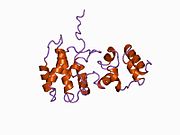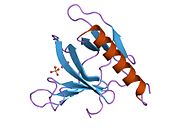From Wikipedia, the free encyclopedia
Protein-coding gene in the species Homo sapiens
Cytohesin-1 formerly known as Pleckstrin homology, Sec7 and coiled/coil domains 1 (PSCD1) is a protein that in humans is encoded by the CYTH1 gene .[ 5] [ 6] [ 7]
Cytohesin-1 (CYTH1) is a member of the cytohesin family. Members of this family have identical structural organization that consists of an N-terminal coiled-coil motif, a central Sec7 domain, and a C-terminal pleckstrin homology (PH) domain. The coiled-coil motif is involved in homodimerization , the Sec7 domain contains guanine-nucleotide exchange protein (GEP) activity, and the PH domain interacts with phospholipids and is responsible for association of CYTHs with membranes. Members of this family appear to mediate the regulation of protein sorting and membrane trafficking. The CYTH1 is highly expressed in natural killer and peripheral T cells , and regulates the adhesiveness of integrins at the plasma membrane of lymphocytes . CYTH1 protein is 83% homologous to CYTH2 .[ 7]
CYTH1 has been shown to interact with:
^ a b c GRCh38: Ensembl release 89: ENSG00000108669 – Ensembl , May 2017^ a b c GRCm38: Ensembl release 89: ENSMUSG00000017132 – Ensembl , May 2017^ "Human PubMed Reference:" . National Center for Biotechnology Information, U.S. National Library of Medicine .^ "Mouse PubMed Reference:" . National Center for Biotechnology Information, U.S. National Library of Medicine .^ Liu L, Pohajdak B (September 1992). "Cloning and sequencing of a human cDNA from cytolytic NK/T cells with homology to yeast SEC7". Biochim. Biophys. Acta . 1132 (1): 75–8. doi :10.1016/0167-4781(92)90055-5 . PMID 1511013 . ^ Dixon B, Mansour M, Pohajdak B (April 1993). "Assignment of human B2-1 gene (D17S811E) to chromosome 17qter by PCR analysis of somatic cell hybrids and fluorescence in situ hybridization". Cytogenet. Cell Genet . 63 (1): 42–4. doi :10.1159/000133498 . PMID 8449036 . ^ a b "Entrez Gene: PSCD1 pleckstrin homology, Sec7 and coiled-coil domains 1(cytohesin 1)" .^ Schürmann A, Schmidt M, Asmus M, Bayer S, Fliegert F, Koling S, Massmann S, Schilf C, Subauste MC, Voss M, Jakobs KH, Joost HG (April 1999). "The ADP-ribosylation factor (ARF)-related GTPase ARF-related protein binds to the ARF-specific guanine nucleotide exchange factor cytohesin and inhibits the ARF-dependent activation of phospholipase D" . J. Biol. Chem . 274 (14): 9744–51. doi :10.1074/jbc.274.14.9744 PMID 10092663 . ^ Rietzler M, Bittner M, Kolanus W, Schuster A, Holzmann B (October 1998). "The human WD repeat protein WAIT-1 specifically interacts with the cytoplasmic tails of beta7-integrins" . J. Biol. Chem . 273 (42): 27459–66. doi :10.1074/jbc.273.42.27459 PMID 9765275 . ^ Geiger C, Nagel W, Boehm T, van Kooyk Y, Figdor CG, Kremmer E, Hogg N, Zeitlmann L, Dierks H, Weber KS, Kolanus W (June 2000). "Cytohesin-1 regulates beta-2 integrin-mediated adhesion through both ARF-GEF function and interaction with LFA-1" . EMBO J . 19 (11): 2525–36. doi :10.1093/emboj/19.11.2525 . PMC 212768 PMID 10835351 . ^ Vitale N, Pacheco-Rodriguez G, Ferrans VJ, Riemenschneider W, Moss J, Vaughan M (July 2000). "Specific functional interaction of human cytohesin-1 and ADP-ribosylation factor domain protein (ARD1)" . J. Biol. Chem . 275 (28): 21331–9. doi :10.1074/jbc.M909642199 PMID 10748148 .
Andersson B, Wentland MA, Ricafrente JY, Liu W, Gibbs RA (1996). "A "double adaptor" method for improved shotgun library construction". Anal. Biochem . 236 (1): 107–13. doi :10.1006/abio.1996.0138 . PMID 8619474 . Kolanus W, Nagel W, Schiller B, Zeitlmann L, Godar S, Stockinger H, Seed B (1996). "Alpha L beta 2 integrin/LFA-1 binding to ICAM-1 induced by cytohesin-1, a cytoplasmic regulatory molecule" . Cell . 86 (2): 233–42. doi :10.1016/S0092-8674(00)80095-1 PMID 8706128 . S2CID 18390795 . Meacci E, Tsai SC, Adamik R, Moss J, Vaughan M (1997). "Cytohesin-1, a cytosolic guanine nucleotide-exchange protein for ADP-ribosylation factor" . Proc. Natl. Acad. Sci. U.S.A . 94 (5): 1745–8. Bibcode :1997PNAS...94.1745M . doi :10.1073/pnas.94.5.1745 PMC 19987 PMID 9050849 . Yu W, Andersson B, Worley KC, Muzny DM, Ding Y, Liu W, Ricafrente JY, Wentland MA, Lennon G, Gibbs RA (1997). "Large-scale concatenation cDNA sequencing" . Genome Res . 7 (4): 353–8. doi :10.1101/gr.7.4.353 . PMC 139146 PMID 9110174 . Nagel W, Zeitlmann L, Schilcher P, Geiger C, Kolanus J, Kolanus W (1998). "Phosphoinositide 3-OH kinase activates the beta2 integrin adhesion pathway and induces membrane recruitment of cytohesin-1" . J. Biol. Chem . 273 (24): 14853–61. doi :10.1074/jbc.273.24.14853 PMID 9614087 . Betz SF, Schnuchel A, Wang H, Olejniczak ET, Meadows RP, Lipsky BP, Harris EA, Staunton DE, Fesik SW (1998). "Solution structure of the cytohesin-1 (B2-1) Sec7 domain and its interaction with the GTPase ADP ribosylation factor 1" . Proc. Natl. Acad. Sci. U.S.A . 95 (14): 7909–14. Bibcode :1998PNAS...95.7909B . doi :10.1073/pnas.95.14.7909 PMC 20903 PMID 9653114 . Nagel W, Schilcher P, Zeitlmann L, Kolanus W (1998). "The PH domain and the polybasic c domain of cytohesin-1 cooperate specifically in plasma membrane association and cellular function" . Mol. Biol. Cell . 9 (8): 1981–94. doi :10.1091/mbc.9.8.1981 . PMC 25450 PMID 9693361 . Pacheco-Rodriguez G, Meacci E, Vitale N, Moss J, Vaughan M (1998). "Guanine nucleotide exchange on ADP-ribosylation factors catalyzed by cytohesin-1 and its Sec7 domain" . J. Biol. Chem . 273 (41): 26543–8. doi :10.1074/jbc.273.41.26543 PMID 9756891 . Rietzler M, Bittner M, Kolanus W, Schuster A, Holzmann B (1998). "The human WD repeat protein WAIT-1 specifically interacts with the cytoplasmic tails of beta7-integrins" . J. Biol. Chem . 273 (42): 27459–66. doi :10.1074/jbc.273.42.27459 PMID 9765275 . Schürmann A, Schmidt M, Asmus M, Bayer S, Fliegert F, Koling S, Massmann S, Schilf C, Subauste MC, Voss M, Jakobs KH, Joost HG (1999). "The ADP-ribosylation factor (ARF)-related GTPase ARF-related protein binds to the ARF-specific guanine nucleotide exchange factor cytohesin and inhibits the ARF-dependent activation of phospholipase D" . J. Biol. Chem . 274 (14): 9744–51. doi :10.1074/jbc.274.14.9744 PMID 10092663 . Pacheco-Rodriguez G, Patton WA, Adamik R, Yoo HS, Lee FJ, Zhang GF, Moss J, Vaughan M (1999). "Structural elements of ADP-ribosylation factor 1 required for functional interaction with cytohesin-1" . J. Biol. Chem . 274 (18): 12438–44. doi :10.1074/jbc.274.18.12438 PMID 10212218 . Venkateswarlu K, Gunn-Moore F, Tavaré JM, Cullen PJ (1999). "EGF-and NGF-stimulated translocation of cytohesin-1 to the plasma membrane of PC12 cells requires PI 3-kinase activation and a functional cytohesin-1 PH domain". J. Cell Sci . 112 ( Pt 12) (12): 1957–65. doi :10.1242/jcs.112.12.1957 . PMID 10341214 . Ogasawara M, Kim SC, Adamik R, Togawa A, Ferrans VJ, Takeda K, Kirby M, Moss J, Vaughan M (2000). "Similarities in function and gene structure of cytohesin-4 and cytohesin-1, guanine nucleotide-exchange proteins for ADP-ribosylation factors" . J. Biol. Chem . 275 (5): 3221–30. doi :10.1074/jbc.275.5.3221 PMID 10652308 . Vitale N, Pacheco-Rodriguez G, Ferrans VJ, Riemenschneider W, Moss J, Vaughan M (2000). "Specific functional interaction of human cytohesin-1 and ADP-ribosylation factor domain protein (ARD1)" . J. Biol. Chem . 275 (28): 21331–9. doi :10.1074/jbc.M909642199 PMID 10748148 . Lee SY, Mansour M, Pohajdak B (2000). "B2-1, a Sec7- and pleckstrin homology domain-containing protein, localizes to the Golgi complex". Exp. Cell Res . 256 (2): 515–21. doi :10.1006/excr.2000.4845 . PMID 10772823 . Geiger C, Nagel W, Boehm T, van Kooyk Y, Figdor CG, Kremmer E, Hogg N, Zeitlmann L, Dierks H, Weber KS, Kolanus W (2000). "Cytohesin-1 regulates beta-2 integrin-mediated adhesion through both ARF-GEF function and interaction with LFA-1" . EMBO J . 19 (11): 2525–36. doi :10.1093/emboj/19.11.2525 . PMC 212768 PMID 10835351 . Dierks H, Kolanus J, Kolanus W (2001). "Actin cytoskeletal association of cytohesin-1 is regulated by specific phosphorylation of its carboxyl-terminal polybasic domain" . J. Biol. Chem . 276 (40): 37472–81. doi :10.1074/jbc.M101502200 PMID 11438522 . Tang P, Cheng TP, Agnello D, Wu CY, Hissong BD, Watford WT, Ahn HJ, Galon J, Moss J, Vaughan M, O'Shea JJ, Gadina M (2002). "Cybr, a cytokine-inducible protein that binds cytohesin-1 and regulates its activity" . Proc. Natl. Acad. Sci. U.S.A . 99 (5): 2625–9. Bibcode :2002PNAS...99.2625T . doi :10.1073/pnas.052712999 PMC 122398 PMID 11867758 .
PDB gallery
1bc9 : CYTOHESIN-1/B2-1 SEC7 DOMAIN, NMR, MINIMIZED AVERAGE STRUCTURE
1u2b : Triglycine variant of the Grp1 Pleckstrin Homology Domain unliganded









